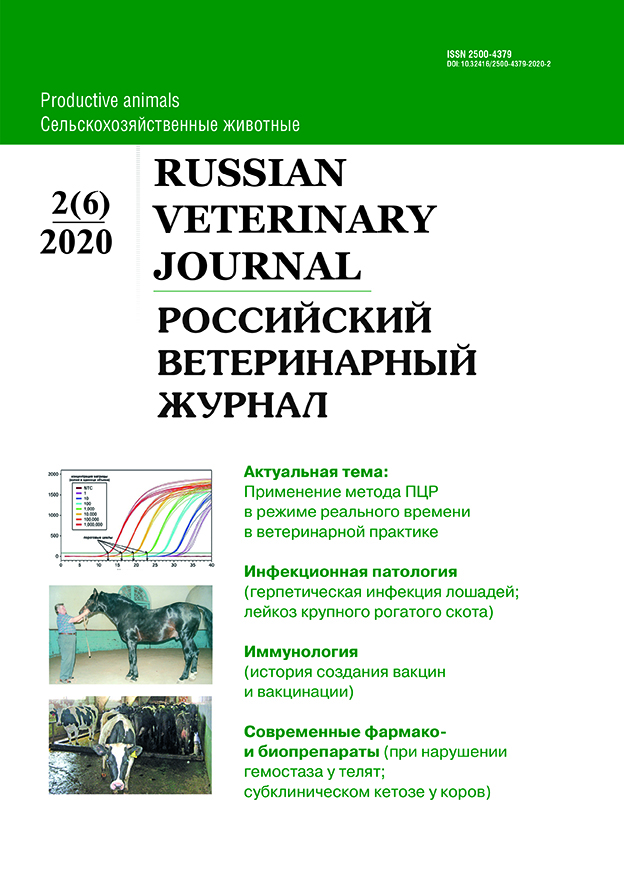Moskva, Moscow, Russian Federation
Moskva, Moscow, Russian Federation
CSCSTI 68.41
Equine alphaherpesviruses ― causative agents of rhinopneumonitis−viral abortion (EHV-1) and rhinopneumonitis (EHV-4) ― represent the subfamily Alphaherpesvirinae, genus Varicellovirus. EHV-1 causes abortion, respiratory pathology, and neurological disorders in horses of different ages. EHV-4 causes predominantly respiratory disease in foals and sporadic abortions in mares. In the etiopathogenesis of herpesvirus infections EHV-1 and EHV-4, the determining factors are pronounced tropism to epithelial cells, persistence in a non-replicative form, and unpredictable reactivation of a persistent virus with its release into the environment. EHV-1 and EHV-4 have similar antigenic determinants and cross-react in serological reactions. The high level of antigenic relationship between EHV-1 and EHV-4 can make it difficult to interpret serologic results in natural infections. The EHV-1 and EHV-4 strains in active circulation are genetically rather conservative. The exception is the new EHV-1 strains with a mutation in the gene encoding viral DNA polymerase, which caused outbreaks of neuroparalytic disease in some European countries and the United States. In several cases, the neurological syndrome has been reported due to use of some commercial vaccines
rhinopneumonitis, herpesvirus, horses, genome, polypeptides, antigens
1. Alekseenkova, S.V. Diagnostika virusnyh bolezney loshadey metodom PCR / S.V. Alekseenkova, G.K. Yurov, K.P. Yurov // Rossiyskiy veterinarnyy zhurnal. - 2011. - № 3. - S. 37-39.
2. Alekseenkova, S.V. Effektivnost' immunizacii myshey linii BALB/c pri intracerebral'nom zarazhenii gerpesvirusom loshadey 1-go tipa / S.V. Alekseenkova, G.K. Yurov, I.Yu. Tkachev, K.P. Yurov // Immunologiya. - 2006. - T. 27. - № 6. - S. 361-363.
3. D'yachenko, P.A. Kak virusu prostogo gerpesa udaetsya pozhiznenno persistirovat' v organizme hozyaina? / P.A. D'yachenko, A.G. D'yachenko // Visnik SumDU. Seriya Medicina. - 2011. - № 1. - S. 1-10.
4. Neustroev, M.P. Novye sredstva i metody profilaktiki infekcionnyh bolezney loshadey tabunnogo soderzhaniya / M.P. Neustroev, K.P. Yurov // Doklady Rossiyskoy akademii sel'skohozyaystvennyh nauk. - 2006. - № 1. - S. 54-56.
5. Tataurova, A.V. Neyropatogennye shtammy vozbuditelya rinopnevmonii - virusnogo aborta loshadey / A.V. Tataurova, K.P. Yurov, S.V. Alekseenkova // Veterinariya. - 2006. - № 3. - S. 21-23.
6. Yurov, K.P. Profilaktika virusnyh bolezney loshadey / K.P. Yurov // M.: KolosS. - 1984. - 143 s.
7. Yurov, K.P. Gerpesvirus loshadey tipa 5 - vozbuditel' fibroza legkih / K.P. Yurov, S.V. Alekseenkova, G.K. Yurov // Veterinariya. - 2013. - №3. - S. 17-21.
8. Allen, G.P. Respiratory Infections by Equine Herpesvirus Types 1 and 4 / G.P. Allen // In Book: Equine Respiratory Diseases (edited by P. Lekeux). - NY, USA.: International Veterinary Information Service, 2002. - www.ivis.org.
9. Azab, W. Glycoproteins D of equine herpesvirus type 1 (EHV-1) and EHV-4 determine cellular tropism independently of integrins / W. Azab, N. Osterrieder // Journal of Virology. - 2012. - Vol. 86(4). - pp. 2031-2044. doi:https://doi.org/10.1128/JVI.06555-11.
10. Ma, G. Equine herpesviruses type 1 (EHV-1) and 4 (EHV-4)--masters of co-evolution and a constant threat to equids and beyond / G. Ma, W. Azab, N. Osterrieder // Veterinary Microbiology. - 2013. - Vol. 167(1-2). - pp. 123-134. doi:https://doi.org/10.1016/j.vetmic.2013.06.018.
11. Nugent, J. Analysis of Equid Herpesvirus 1 Strain Variation Reveals a Point Mutation of the DNA Polymerase Strongly Associated with Neuropathogenic versus Nonneuropathogenic Disease Outbreaks / J. Nugent, I. Birch-Machin, K.C. Smith, J.A. Mumford, Z. Swann, J.R. Newton, R.J. Bowden, G.P. Allen, N. Davis-Poynter // Journal of Virology. - 2006. - Vol. 80 (8). - pp. 4047-4060.
12. Oladunni, F.S. EHV-1: A constant threat to the horse industry / F. S. Oladunni, D. W. Horohov, T.M. Chambers // Frontiers in Microbiology. - 2019. - Vol. 10. - article №2668.
13. Pagamjav, O. Natural recombinant between equine herpesviruses 1 and 4 in the ICP4 gene / O. Pagamjav, T. Sakata, T. Matsumura, T. Yamaguchi, H. Fukushi // Microbiology and Immunology. - 2005. - Vol. 49(2). - pp.167-179.
14. Spiesschaert, B. Comparative analysis of glycoprotein B (gB) of equine herpesvirus type 1 and type 4 (EHV-1 and EHV-4) in cellular tropism and cell-to-cell transmission / B. Spiesschaert, N. Osterrieder, W. Azab // Viruses. - 2015. - Vol. 7(2). - pp. 522-542. doi:https://doi.org/10.3390/v7020522.
15. Studdert, M.J. Molecular epidemiology and pathogenesis of some equine herpesvirus type 1 (equine abortion virus) and type 4 (equine rhinopneumonitis virus) isolates / M.J. Studdert, D.R. Fitzpatrick, G.W. Horner, H.A. Westbury, L.J. Gleeson // Australian Veterinary Journal. - 1984. - Vol. 61 (11). - pp. 345-348.
16. Thormann, N. The role of secreted glycoprotein G of equine herpesvirus type 1 and type 4 (EHV-1 and EHV-4) in immune modulation and virulence / N. Thormann, G.R. Van de Walle, W. Azab, N. Osterrieder // Virus Research. - 2012. - Vol. 169(1). - P. 203-211. doi:https://doi.org/10.1016/j.virusres.2012.07.029.








